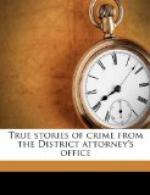While the evidence affords a motive for Patrick to desire the death of Mr. Rice, it does not of itself, up to this point, indicate the slightest intention on the part of Patrick to do away with the old gentleman. It was therefore conceded by the prosecution that, upon Jones’s own testimony, the conspiracy to murder was not formed until about seven weeks before the event. The first evidence which points to an intent to murder is the famous “cremation letter,” dated August 3d.
The cremation letter from Mr. Rice, authorizing Patrick to cremate his body, shows that Patrick intended to do away with Rice in such a way that an autopsy must, if possible, be prevented and the evidence of murder destroyed. That Patrick forged such a letter was evidence that his connection with the murder was premeditated and deliberate. To cremate the body before an autopsy it was necessary to procure a physician’s certificate that Rice had died from natural causes. He therefore made preparation to secure such a certificate, and then upon the strength of the cremation letter to give directions for the immediate destruction of the body.
Patrick, with the view of having at hand a physician who would be unsuspicious, and who would issue a certificate of death from natural causes, induced Jones to send for Dr. Curry, his own friend and physician, on an occasion when the valet was ill. This was in March, 1900. Dr. Curry came, and Jones, acting under Patrick’s advice, cautioned him not to mention the lawyer’s name to Rice. In course of time he saw Rice, gained his good opinion and became his attending physician. But Rice did not die, and curiously enough it was he himself who suggested to Jones the instrumentality of death which was finally employed, for he read an article dealing with the dangers of chloroform as an anaesthetic, and discussed it with the valet. This suggestion was conveyed to Patrick, who asked Dr. Curry whether chloroform left any traces discoverable upon an autopsy. Dr. Curry rather carelessly replied that it left but slight traces if administered only in the quantities which would be fatal to a man with a weak heart. Patrick told Jones, so Jones alleges, to procure some chloroform and this he did, sending to Texas for two bottles of two ounces each. From Dr. Curry’s remarks it was manifest that a weakened condition of the patient was an important element, and as Jones was taking some mercury pills (prescribed for him by Dr. Curry), the valet induced his master to take some of them. The old gentleman was benefited, however, rather than weakened. This was before the forgery of the cremation letter. It was clear that larger doses of mercury would be necessary, and accordingly Patrick furnished Jones with pellets containing the drug in such quantities that Jones, experimenting with one of them, became ill.




